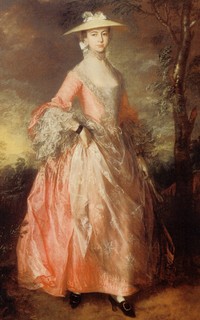
Marquesses
Info is from: The Peerage of England, 1766 [broken link to books.google.co.uk]."His robe in parliament is of fine scarlet cloth, lined with white taffata, and has four guards of ermine on the right side, and three on the left, set at equal distance, with a gold lace above each guard, and is tied up on the left shoulder with a ribbon. His cap is of crimson velvet, lined with ermine, having a gold button and tassel on the top, and his coronet, which is also of gold, is part flowered, and part pyramidal, with the point having pearls on the top, and leaves or flowers of equal height.
His coronation surcoat or mantle, is of crimson velvet, lined with white taffata, and the mantle is doubled from the neck to below the elbow, with ermine, having four rows of spots on the right I shoulder, and three on the left.
This honour is hereditary, and he is called most noble and puissant Prince ; his eldest son taking his second title, is called in courtesy, Earl, or Lord etc and the younger sons Lords, by their christian names; and the daughters are styled Ladies."
If I had realized long ago how rare marquesses were in the 18th century I wouldn't have used the title, but I'm committed now, so that's part of my unreal 18th century. In addition to my Marquess of Rothgar and Marquess of Ashart, we have....
Rockingham, b 1730, m 1754, Marquessate created in 1745.